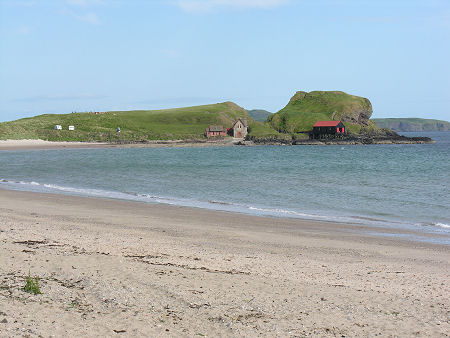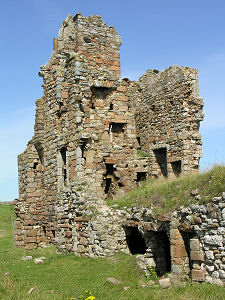 Dunaverty Head, Site of Dunaverty Castle, from the West |
General David Leslie, Lord Newark, lived from 1601 to 1682. He was a professional soldier who played an important part in the Wars of the Three Kingdoms in the middle of the 1600s. The wider picture in Scotland at the time is set out in our Historical Timeline.
David Leslie was the fifth son of Patrick Leslie, Lord Lindores, and Lady Jean Stewart. In 1630 he joined many young Scots recruited by Alexander Leslie, 1st Earl of Leven, to serve in the army of King Gustavus Adolphus of Sweden. At the time Sweden was heavily engaged in the Thirty Years' War. By 1634, David Leslie had risen through the ranks to become commander of a cavalry regiment with the rank of colonel.
Along with many other Scottish officers in the Swedish army, David Leslie followed Field Marshal Alexander Leslie back to Scotland to support the Scottish Covenanters in the Bishops' Wars against England. In 1644, he was appointed Lieutenant-General, second in charge of the Scottish Covenanter army, under Alexander Leslie, sent to fight alongside the English Parliamentarians. David Leslie first made his name at the Battle of Marston Moor on 2 July 1644, when his cavalry charge tipped the scales in favour of the Parliamentary forces and saved a wounded Oliver Cromwell.
In 1645, David Leslie was sent back to Scotland to deal with Royalists under James Graham, 1st Marquess of Montrose who had inflicted a spectacular series of defeats on the Covenanters. On 12 September 1645, Leslie's forces intercepted Montrose at Philiphaugh near Selkirk and soundly defeated him. Back in England, Leslie took command of the siege of the Royalist stronghold at Newark, and it was to him that Charles I surrendered on 5 May 1646. He transferred his prisoner to the custody of Alexander Leslie in Newcastle before taking command of the eradication of remaining Royalist forces in Scotland. In 1647 his forces pursued a Royalist force under the command of Sir Alexander MacDonald down the length of Kintyre. The Royalists sought refuge in Dunaverty Castle, and after a siege were defeated by the Covenanters. Those of the defenders not killed in the immediate action were then executed by Leslie's forces. In all, some 300 people, mainly MacDonalds and MacDougalls, were killed.
During a brief peaceful interlude in 1649, Leslie purchased Newark Castle on the Fife coast with a view to turning it into a grand family home. In 1650, however, he was appointed second in command of a new Scottish Covenanter army, this time with the intention of helping restore Charles II to the throne of England and defeat the Parliamentarians. In July 1650 Oliver Cromwell pre-empted the planned Scottish invasion with an invasion of his own. Cromwell's forces were held initially by Scottish forces under Alexander Leslie, but then defeated the Covenanters under the command of David Leslie at the Battle of Dunbar on 3 September 1650. The result was the conquest and occupation of southern Scotland by Cromwell.
Charles II was nonetheless crowned King of Scots on 1 January 1651 and the campaign to restore him to the English throne continued. It came to a final end in defeat at the Battle of Worcester on 3 September 1651. David Leslie was captured by Parliamentarians after the battle and he spent the next nine years as a prisoner in the Tower of London. Released after the restoration of Charles II in 1660, Leslie returned to Scotland, where he was made 1st Baron Newark, and lived out his days at Newark Castle, dying in 1682.

